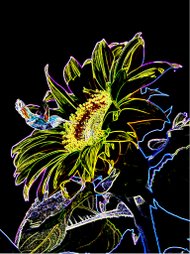One common complaint about hydroponics is the smell that often results, but with a little care and knowledge, a well run hydroponics system doesn’t need to end up becoming a slimy, smelly mess and odor problems can be easily avoided.
Tip #1 – Keep the system as free of organic materials as possible
Nutrient solution problems are often the cause of bad smell in hydroponics systems.
Bad odors can be both strong and persistent and are a result of bacteria metabolizing proteins which releases amines and sulfur containing organic molecules into solution. Microbial growth in the nutrient itself is a result of having organic materials in the system somewhere (fungi etc need organic matter to feed on). Because of this, it is important to avoid introducing unnecessary organic material into the nutrient solution or growing media. Organic matter may have come from large amounts of old rotting root systems or vegetation from a previous crop or use of organic growing media. Take steps to avoid these problems by using non organic starting medium for starting plants to be added to the system and a non-organic growing medium in the system. Between crops replace or clean the growing medium to remove unwanted organic matter. Use a dark reservoir and keep it covered to keep light and foreign organic matter out.
Tip #2 – Take Steps to Maintain a Microbial Equilibrium in the System
The microbial species which produce the bad smells, slime and other undesirable problems are not to be encouraged, but there are beneficial microbes that can be added and encouraged in the system. First, start with a clean, sterilized water source, add in the nutrients, and then inoculate the nutrient solution with a mixture of beneficial microbes (see product list below). This gives the beneficial microbes a head start and results in a healthy system where any pathogens should be suppressed before plant damage occurs. The following are some well know products that contain beneficial bacteria:
Advanced Nutrients TarantulaTM contains 19 types of organic beneficial bacteria that colonize plant roots and leaves.
Beneficials Bio-Link PlusTM is organic and contains naturally occurring organisms, beneficial Microbes and Fungi that aid in the natural process of plant growth and development.
Dr Hornb’s Piranha PowderTM and Voodoo JuiceTM. Voodoo Juice colonizes the root zone with friendly bacteria. Piranha Powder colonizes the root zone with 26 different beneficial fungi. These include 8 species of Trichoderma (which encourage root growth and protect against fungal pathogens) and 18 species of endo and ecto micorrhizal (which help break down nutrients, aid structure and improve uptake).
Ell-Gro Ag-Bact Water PolishTM consists of thirty varietel aerobic (pro-biotics) bacteria. These pro-biotics are cultures in a registered NATA micro-biological laboratory using a recipe compiles by agricultural scientists.
FlourishTM works symbiotically with native microbes to maximize the sub-surface decomposition of organic plant and animal materials and fertilizers making their rich organic nutrients that plants have grown to love almost immediately available.
Tip #3 – Use Only Nutrients and Additives that are Specifically Designed for Hydroponics
Avoid the use of organic fertilizers which are used and designed for soil based systems. Many of these rely on boosting the population growth of microbes in the soil which in turn break down organic matter, releasing nutrients. Many of the organic compounds are not fully mineralized and putting these soil based organic fertilizers (such as fish emulsions) into a hydroponics system in large quantities can have rapid and unpleasant results.
Tip #4 Keep the Nutrient Solution Well Oxygenated
Start with a clean system and keep the nutrient well oxygenated. This helps swing the equilibrium in favor of the beneficial microbes and provides oxygenated solution to the plant roots. Air pumps are now very inexpensive and should be used with an air stone to add oxygen to the nutrient solution. Plant only healthy seedlings into the system in non organic starting media and remove any sick or stressed plants as soon as they are noticed, making sure to get most of the roots.
Tip #5 Flush the System and Replace the Nutrient Solution Often
It is possible to test nutrient solution often and maintain proper pH and nutrient levels, but it is beneficial and much easier to replace the solution every week or at least every two weeks. Set the system up so a water pipe can be easily opened to drain the system. Plan to drain the system when the reservoir is already low. Drain the solution into a watering can until the pump starts to draw air. Use this nutrient rich water to water soil based plants. Add a gallon or two of pH adjusted water to the system and run the system for five minutes to flush. Drain the system again and then fill with pH adjusted nutrient solution and beneficial microbes.
Tip #6 Consider Ozone Generators and Carbon Filters
Ozone Generators and Carbon Filters are no substitute for the general hydroponics practices discussed in the previous tips and they may very well be unnecessary for odor control if these tips are diligently applied. They may however have benefits beyond odor control that are worth considering. For example, The Black Max Ozone SystemTM claims to purify the water by injecting ozone directly into the holding tank or the nutrient reservoir. In the water, excess ozone constantly breaks down into oxygen which super oxygenates the nutrient solution, promoting rapid healthy root development, plant growth and higher yields. Carbon Filters are probably the best way of removing odors from any area. Charcoal has long been recognized as one of the best vehicles for air filtering and different size filters are available for different sized growing rooms. Carbon Filters are easy to install and operate.
By consistent application of the above tips a Microbial equilibrium can be created in the hydroponics system that will not only have limited undesirable odors, but will consistently produce better harvests.
Dr. Christopher J. Kline is a master gardener and writer living in Paradise Valley Arizona. Chris can be reached at CKline72@Cox.net
Subscribe to:
Post Comments (Atom)



No comments:
Post a Comment